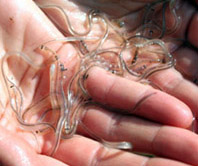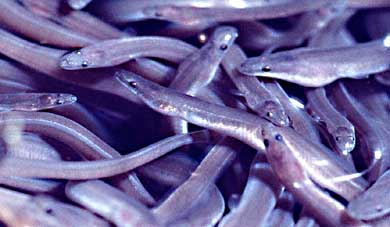Life Cycle and Reproduction
The American eel, Anguilla rostrata, lead a very unusual lifecycle. The eel’s many developmental stages are separated both morphologically and geographically, as they migrate between fresh and seawater to complete a full round of reproduction. According to Oliveira, these eels are a catadromous species, typically being a freshwater species, but moving into salt water to reproduce.
American eels begin their life in the Sargasso Sea, a calm region in the southeast Atlantic Ocean, where the adult eels congregate to spawn and then die. An approximated maximum of four million buoyant eggs are laid by the female eel and then fertilized by the male (ODNR). Hatching typically occurs within a week of fertilization, peaking in February and possibly lasting until April, yielding the larval stage (McCleave et al., 1987).
The larval form of Anguilla rostrata is called the lepthocephalus. According to the U.S. Fish and Wildlife Service (FWS), these transparent larvae are transported to coastal waters by ocean currents while they grow and develop. As they near the coast, the lepthocephalus undergo metamorphosis into the next developmental stage, the glass eel.
The FWS describes this metamorphosis as a decrease in water content, along with changes in the configuration of the head and jaws, leading the slim, elongated eel image that may come to mind. These immature eels still do not contain any pigment and begin to actively migrate toward shore.
As the glass eels near the shoreline, they grow progressively pigmented and are then referred to as elvers. It is still impossible to distinguish the sex of the eels at this stage in the life cycle, says the Committee on the Status of Endangered Wildlife in Canada (COSEWIC). This phase lasts between three and twelve months until the American eel becomes a yellow eel and enters the growth phase.
The yellow American eel grows into an eel with thicker, tougher skin covered in a protective mucous layer. They have scales buried deep within the skin. This is also the stage in which sexual differentiation occurs (COSEWIC). In order to complete its maturation, the American eel must undergo metamorphosis into the final silver eel stage.
The modifications that occur in the yellow to silver metamorphosis are done to prepare the mature Anguilla rostrata for migration back to the Sargasso Sea. These changes include fattening of the body, thickening of the skin, changes in eye pigments to better see in deep oceanic depths, and enlargement of the pectoral fins (FWS). It is known that the female eels are typically older and larger at maturation than the males. This increased size leads to an increased fecundity (Oliveira, 1999). Once the maturation process is complete, the adult American eels migrate back to the Sargasso Sea to begin the process once again.
A summary of this complex lifecycle is shown below, thanks to the Ministry of Natural Resources:

To learn about the interactions the American eel has with other species in its habitat, click here.
Home


